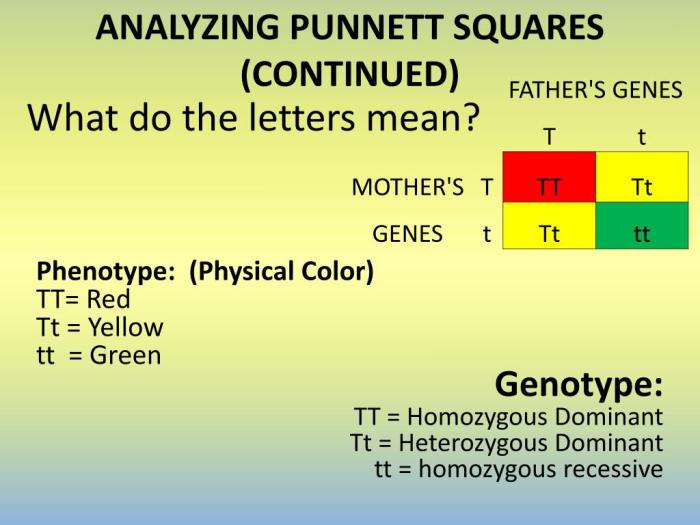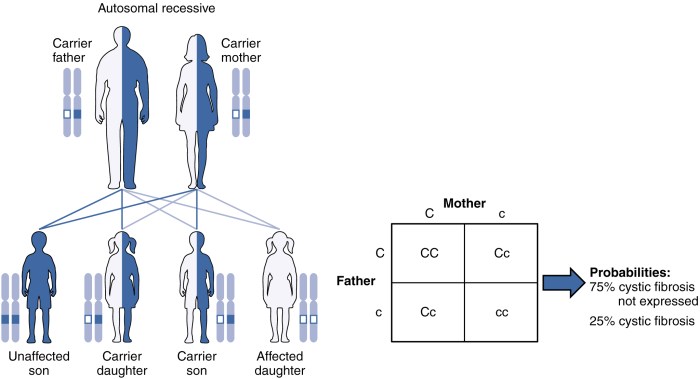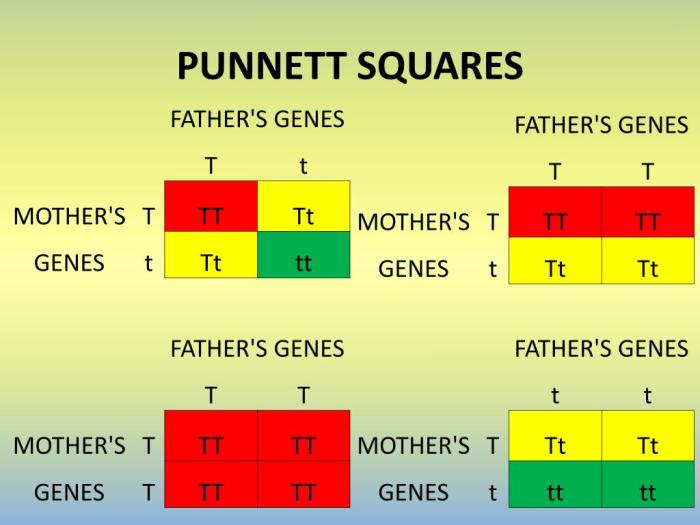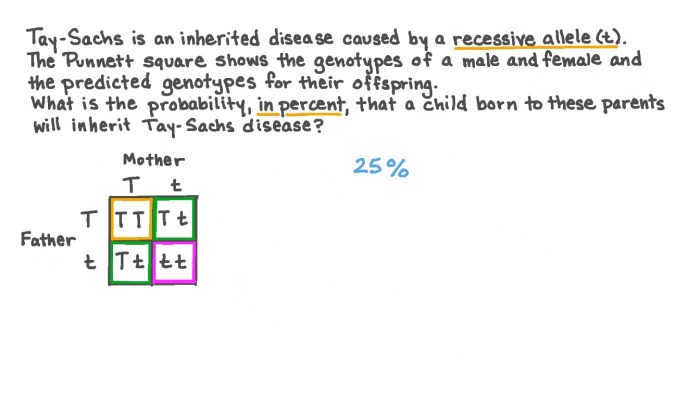Punnett square for tay sachs – Unveiling the intricacies of genetic inheritance, the Punnett square for Tay-Sachs disease provides a crucial tool for understanding the genetic patterns and potential outcomes associated with this devastating condition.
Delving into the specifics of Tay-Sachs disease, we explore its unique genetic makeup and how it manifests in a Punnett square analysis, shedding light on the probabilities of inheritance and the potential implications for individuals and families.
Punnett Square for Tay-Sachs

A Punnett square is a diagram that predicts the possible genotypes of offspring based on the genotypes of their parents. It is a valuable tool in understanding the inheritance patterns of genetic traits. Tay-Sachs disease is an inherited condition caused by a mutation in the HEXA gene.
Understanding the genetic pattern of Tay-Sachs disease using a Punnett square can help predict the likelihood of a child inheriting the condition.
Genetic Pattern of Tay-Sachs Disease
Tay-Sachs disease is an autosomal recessive disorder, meaning that both copies of the HEXA gene must be mutated for an individual to develop the condition. Carriers have only one mutated copy of the gene and do not exhibit symptoms of the disease.
In a Punnett square, the alleles for the HEXA gene are represented by the letters A and a. The normal allele is A, and the mutated allele is a.
- Parents:One parent is a carrier (Aa), and the other parent is unaffected (AA).
- Possible Genotypes of Offspring:50% chance of being carriers (Aa) and 50% chance of being unaffected (AA).
Inheritance Patterns

Tay-Sachs disease is an autosomal recessive genetic disorder, meaning that both copies of the gene responsible for producing the lysosomal enzyme hexosaminidase A (HEXA) must be mutated for an individual to develop the disease.
When both parents are carriers of the Tay-Sachs gene mutation, each parent has a 50% chance of passing on the mutated gene to their offspring. If both parents pass on the mutated gene, the offspring will inherit the disease. If only one parent passes on the mutated gene, the offspring will be a carrier of the Tay-Sachs gene, but they will not develop the disease.
Understanding Punnett squares is crucial for predicting the inheritance patterns of genetic disorders like Tay-Sachs. Speaking of inheritance, the upcoming ATI Peds Proctored Exam 2023 will cover a wide range of pediatric topics, including genetics. By brushing up on Punnett squares, you’ll be well-prepared to tackle questions related to Tay-Sachs and other genetic conditions.
Genotypes and Phenotypes
The following table summarizes the possible genotypes and phenotypes resulting from a Punnett square analysis of Tay-Sachs:
| Genotype | Phenotype |
|---|---|
| AA | Normal (not affected) |
| Aa | Carrier (not affected) |
| aa | Affected (has Tay-Sachs disease) |
Probabilities of Inheritance
The probability of inheriting Tay-Sachs disease depends on the carrier status of the parents. If both parents are carriers, the probability of having an affected child is 25% (1 in 4).
If only one parent is a carrier, the probability of having an affected child is 0% (0 in 4). However, the probability of having a carrier child is 50% (2 in 4).
It is important to note that these probabilities are only estimates. The actual probability of inheriting Tay-Sachs disease may vary depending on the specific mutations involved and other genetic factors.
Clinical Manifestations

Tay-Sachs disease is a progressive, fatal neurodegenerative disorder characterized by a range of clinical manifestations that vary in severity and progression. The genetic information obtained from a Punnett square can provide valuable insights into the potential severity of the disease.
Onset and Symptoms
Tay-Sachs disease typically presents in infancy, with symptoms usually appearing between 3 and 6 months of age. Initial symptoms include:
- Loss of motor skills
- Muscle weakness
- Cherry-red spot in the eye
- Progressive mental deterioration
Progression, Punnett square for tay sachs
As the disease progresses, symptoms become more severe and include:
- Seizures
- Blindness
- Deafness
- Paralysis
- Cognitive impairment
- Difficulty swallowing
The progression of Tay-Sachs disease is relentless, and most children affected by the condition do not survive beyond the age of 5.
Genetic Counseling: Punnett Square For Tay Sachs

Genetic counseling plays a crucial role in Tay-Sachs disease management. It involves providing information and support to individuals and families who are affected or at risk of developing the condition.
A Punnett square analysis can be a valuable tool in genetic counseling. It helps healthcare professionals assess the probability of a couple passing on the Tay-Sachs gene to their offspring. By understanding the inheritance patterns of the disease, individuals can make informed decisions about family planning and reproductive options.
Punnett Square Analysis
A Punnett square is a diagram that shows the possible combinations of alleles that can be inherited from each parent. In the case of Tay-Sachs disease, an individual can inherit two normal alleles (not carrying the Tay-Sachs gene), one normal allele and one Tay-Sachs allele (carrier), or two Tay-Sachs alleles (affected).
The Punnett square can be used to determine the probability of a couple having a child with Tay-Sachs disease. If both parents are carriers, there is a 25% chance that their child will inherit two Tay-Sachs alleles and be affected by the disease.
There is a 50% chance that their child will be a carrier, and a 25% chance that their child will inherit two normal alleles and not be affected.
Genetic counselors use Punnett squares to help individuals and families understand the risks of passing on Tay-Sachs disease. They also provide information about genetic testing, prenatal diagnosis, and reproductive options.
Ethical Considerations

The use of Punnett squares in Tay-Sachs disease raises several ethical considerations that require careful attention. These ethical implications involve the individuals, families, and society as a whole.
Impact on Individuals and Families
Punnett squares can provide valuable information about the likelihood of inheriting Tay-Sachs disease. However, this information can also be emotionally challenging for individuals and families.
- Psychological Distress:Learning about the potential risks of having a child with Tay-Sachs disease can cause significant psychological distress for prospective parents.
- Reproductive Choices:Punnett squares can influence reproductive decisions, such as whether to have children or to undergo genetic testing before conception.
- Stigmatization:Individuals who carry the Tay-Sachs gene may face stigmatization or discrimination due to the potential for passing on the disease.
Impact on Society
The use of Punnett squares also has implications for society as a whole.
- Genetic Discrimination:Punnett squares could be used for genetic discrimination, where individuals are denied access to insurance, employment, or other opportunities based on their genetic information.
- Resource Allocation:The use of Punnett squares may lead to increased demand for genetic testing and counseling services, which could strain healthcare resources.
- Equity and Access:Ensuring equitable access to genetic information and counseling is crucial to prevent disparities in healthcare outcomes.
FAQ
What is a Punnett square?
A Punnett square is a diagram that predicts the possible genotypes of offspring based on the genotypes of their parents.
How does a Punnett square help understand Tay-Sachs disease?
A Punnett square can show the probability of inheriting Tay-Sachs disease based on the genetic makeup of the parents.
What are the clinical manifestations of Tay-Sachs disease?
Tay-Sachs disease is a fatal genetic disorder that affects the nervous system, leading to progressive deterioration and ultimately death.
